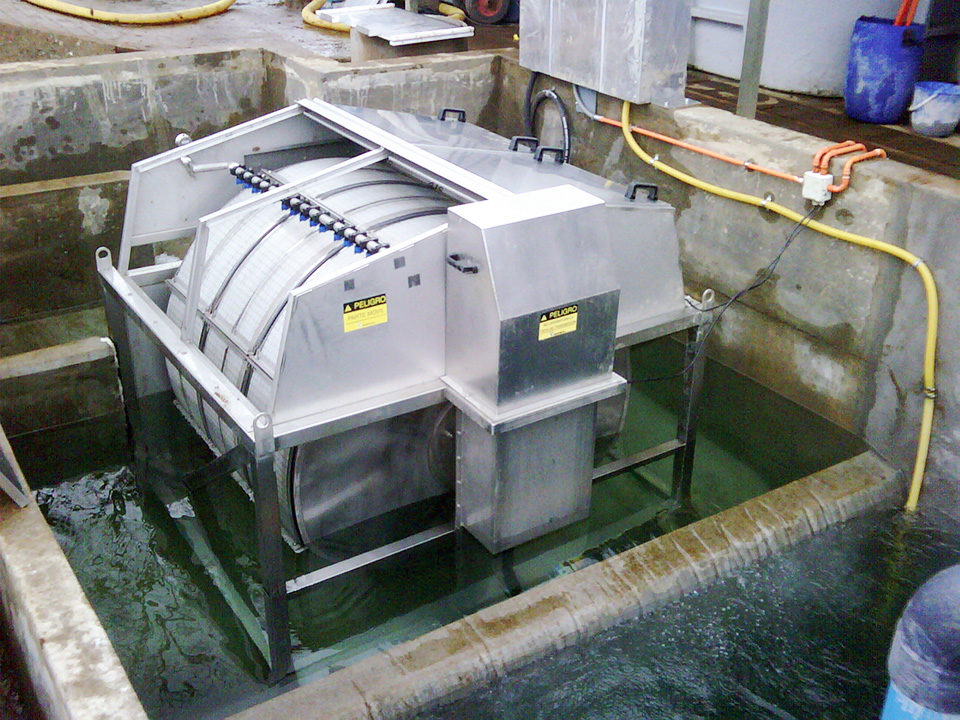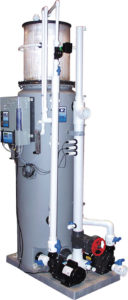In ‘double drain’ configuration, 10 to 15 percent of the flow leaving the tank is removed

Recirculating aquaculture systems (RAS) offer an alternative production technology to flow-through tank-based aquaculture and pond-based aquaculture technology for the nursery culture and grow-out of farmed finfish. Through water treatment and reuse, these systems use a fraction of the water required by ponds or flow-through tanks to produce similar yields. Because recirculating systems usually use tanks for aquaculture production, significantly less land is required. While these systems are not going to completely replace other land based technologies, they are finding their way into the production of advanced fingerlings for stocking large fish in more traditional production systems.
Recirculating technology
RAS technology involves a process by which the environment in an aquaculture culture tank is controlled through water treatment and recirculation. The technology has been developing for more than four decades. Although RAS systems can be costly, claims of impressive yields and the opportunity for year-round production in locations close to major markets using little water attract interest.
In recent years, the salmon industry worldwide has adopted RAS to produce larger smolts to stock into production net pens. We are seeing similar interest from managers of pond-based farms. While there have been some large-scale failures in this business sector, numerous small- to medium-scale efforts continue with success.
Critical processes

Aquaculture production depends upon the delivery of high-quality diets to the fish within a culture tank while maintaining high water quality. The two do not necessarily go hand in hand. Higher feed rates lead to more waste production and the potential for uneaten feed or fecal material to degrade in the culture tank. Critical water quality parameters include the concentrations of dissolved oxygen, un-ionized ammonia nitrogen, nitrite-nitrogen and carbon dioxide, as well as pH and alkalinity values.
As feeds are introduced to the tanks, they are either consumed by the fish or left to decompose within the system. The by-products of fish metabolism include carbon dioxide, ammonia-nitrogen and fecal solids. If uneaten feeds and metabolic by-products are left within tanks or water filtration systems, they degrade and generate additional carbon dioxide and ammonia-nitrogen, while reducing the oxygen content of the water.
The carrying capacity of RAS production systems must be carefully designed to provide for the cost-effective production of fish. A number of treatment processes, or “unit processes,” are critical to the design of successful production systems. These unit processes must be implemented in the right order, and the success of RAS systems also depends upon the correct sizing of the components involved.
If a component is too small, a barrier is created that can limit the productivity of the production system, often resulting in the inability to meet financial goals. Similarly, a component for a water treatment process can be oversized to the point where the capacity of the component is never reached. As such, the RAS technology is paid for but not used.
Unit processes
As noted above, key to building and operating a successful recirculating aquaculture production system is the use of right-sized, cost-effective water treatment components. All recirculating production system technology must remove waste solids, oxidize ammonia and nitrite-nitrogen to nitrate-nitrogen, remove carbon dioxide and add dissolved oxygen to the water by aeration or the use of oxygen gas before returning it to the culture tank. More-intensive systems or systems culturing sensitive species or delicate larval and nursery life stages may require additional treatment processes, such as fine-solids removal, dissolved organics removal and/or some form of disinfection.
Solid waste

One of the most important unit processes in RAS production technology is waste solids removal. Pelleted diets used in aquaculture production consist of protein, carbohydrates, fat, vitamin and mineral packs, and water. The portion of feeds not assimilated by fish is excreted as organic wastes, fecal solids and urea. When fecal solids and uneaten feed are degraded by bacteria within the system, dissolved oxygen is consumed, and ammonia-nitrogen is generated. As such, it is imperative that waste solids are removed from the system as quickly as possible.
Waste solids can be classified into three categories: settleable, suspended and dissolved. In RAS, the first two categories are of primary concern. Dissolved solids can become problematic in systems with low water exchange. Settleable solids should be removed from tanks or filtration components quickly. They can be removed as they are deposited on tank bottoms through the proper design and placement of tank drains.
Solids removal
The most popular style of tank drain today is the “double drain.” In this configuration, only about 10 to 15 percent of the flow leaving the tank is removed at the bottom center. Solids are then typically removed from flow with a swirl separator or radial flow separator. The remaining water is removed from higher in the water column, which generally captures the suspended solids in the tank.
From an engineering point of view, the differences between suspended solids and settleable solids are practical. Under fish culture conditions, suspended solids do not settle to tank bottoms and therefore cannot be removed as quickly in the bottom drain. As a result, suspended solids are not always dealt with adequately and can significantly degrade water quality and limit system production.
The most popular method for removing suspended solids involves mechanical filtration. The most common approaches are drum-screen filtration and granular media filtration, usually with pelleted plastic media.
With both of these technologies, it is important to remove the solids from the water flow as quickly as possible. With the bead filter technology, that means backwashing frequently to eliminate the waste from the filter. Drum screens, on the other hand, move into a backwash cycle frequently, usually every few minutes, but generally waste more water than bead filters.
Fine solids
Fine suspended solids with diameters below 30µ contribute more than 50 percent of the total suspended solids that build up in RAS. Fine and dissolved solids are not effectively removed by sedimentation or mechanical filtration technology. Foam fractionation, also called protein skimming, is used to remove these solids in RAS.
In foam fractionation, air bubbles are introduced at the bottom of a column of water, and foam is created at the top air-water interface. As the bubbles rise through the water column, solid particles attach to the bubbles’ surfaces, forming the “dirty” foam at the top of the column. The foam bubbles collapse and flow out of the foam fractionator to a waste drain for disposal or treatment. Solids concentration in the waste flow can be five times greater than that of the culture tank.
Although the efficiency of foam fractionation is subject to the chemical properties of the water, the process generally is more effective in saltwater systems or those with high pH. Most modern foam fractionators utilize venturi devices to inject fine air bubbles at the base of the components.
(Editor’s Note: This article was originally published in the November/December 2013 print edition of the Global Aquaculture Advocate.)
Author
-
Thomas Losordo, Ph.D.
Director
Aquaculture Systems Engineering
Pentair Aquatic EcoSystems, Inc.
1791 Varsity Drive, Suite 140
Raleigh, North Carolina 27606 USA
Related Posts

Health & Welfare
Biofilter inoculation in recirculating aquaculture systems
Biological filters are essential parts of recirculating aquaculture systems that transform toxic fish compounds such as ammonium and nitrite into less-harmful nitrate. The authors tested the convenience and efficiency of three methods for the initial inoculation of aerobic biofilters.

Responsibility
A look at unit processes in RAS systems
The ability to maintain adequate oxygen levels can be a limiting factor in carrying capacities for RAS. The amount of oxygen required is largely dictated by the feed rate and length of time waste solids remain within the systems.

Innovation & Investment
A review of unit processes in RAS systems
Since un-ionized ammonia-nitrogen and nitrite-nitrogen are toxic to most finfish, controlling their concentrations in culture tanks is a primary objective in the design of recirculating aquaculture systems.

Innovation & Investment
Competitiveness comes at scale for RAS operations
Total RAS salmon production worldwide is less than half of 1 percent of total production. Many of the investors flocking to the sector now are new to fish farming, and confident in its potential.


